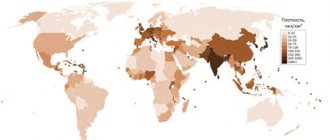Development of a geography lesson on the topic “Countries of the World”
09/24/2018
Geography
7th grade
Lesson 7
Subject. Countries of the world
Goals:
• Form an idea of the diversity of countries in the world. • Develop the ability to analyze diagrams.
Planned result
Personal UUD
: development of cognitive needs and motivation for learning based on analysis of the political map of the world and other sources of geographic information; formation of a holistic worldview that takes into account the diversity of the modern world.
Intersubject UUD:
developing skills to work with different sources of information - a political map of the world, a map, a diagram and diagrams; develop the motives and interests of your cognitive activity based on the analysis of the political map of the world and other sources of geographic information: diagrams, diagrams and paragraph maps; build logical reasoning and draw conclusions.
Subject UUD
: the formation of ideas and theoretical knowledge about the diversity of the countries of the world and their differences, about the types of government systems of the countries of the world, about the economy (economy) of countries and the stages of its development, the level of economic development of countries and their interrelations.
Equipment:
textbook, atlas, political map of the world.
Main content:
countries of the world. Diversity of countries of the world. Republic. Monarchy. Economically developed countries of the world. Dependence of countries on each other.
During the classes
- Organizational moment
- Homework check:
1.
Why is population density different in different parts of the world?
2.
Name and show on the map the largest countries in the world by population.
3.
Name the main reasons influencing population changes. - Learning new material:
Currently there are more than 230 states. Countries around the world differ in many ways. We studied some of the characteristics by which countries can be divided in previous lessons (by number, by predominant religion, by predominant language). Countries can be divided according to the size of the territory they occupy. Students are asked to find on a political map the largest countries in the world by area - Russia, Canada, China, USA, Brazil, Australia. Their area is slightly less than half of the total land area. At the same time, there are very small countries, for example the Vatican. Its area is only a few blocks of Rome. Such states are called dwarf states. These include Monaco, Andorra, San Marino and some other countries. Countries are also distinguished by geographical location. The largest number of countries are located on continents. Some of them have access to the sea, others are hundreds and thousands of kilometers away from it. There are island countries, occupying one or more islands, and peninsular countries. (Give examples of countries with different geographical locations.) An important distinguishing feature of any country is its political structure and level of economic development (or economic power of the country). Students determine the political structure of countries independently using the text in § 7 and fill out table 11.
Table
Forms of government in countries around the world
| Form of government | A country |
| Monarchy - absolute - constitutional | |
| Republic - presidential - parliamentary | |
| Dependent territories (indicating status) |
To distinguish countries with different economic levels, there are different indicators that students will become familiar with in high school. The main indicator is the cost of goods and services produced in the country for the year. Figure 16 of the textbook shows ten economically developed countries of the world. Next, students are asked to analyze the employment structure of the population in the presented countries (Fig. 17 of the textbook) and identify the most important geographical and economic factors that influenced the current ratio. Homework:
1) study § 7; 2) answer the questions and complete the tasks after the paragraph.
Geography lesson plan, 7th grade
Plan - lesson notes on the topic “Australia.
Peculiarities of Australian nature" in 7th grade. Goal: to form a general idea of the uniqueness of the nature of the smallest continent; revealing the reason for this uniqueness. Tasks . Educational: establish the correctness, completeness and awareness of homework, identify and eliminate problems discovered during the inspection; determine which natural areas are represented in Australia; introduce students to the most prominent representatives of the organic world of Australia; ensure perception, comprehension and primary memorization of the material being studied; ensure the formation of an integral system of knowledge about the uniqueness of the nature of the smallest continent; reveal the reasons for this uniqueness; ensure, during consolidation, an increase in the level of comprehension of the studied material. Educational: environmental education of students using the example of the attitude of Australians to their country and nature; fostering camaraderie, kindness, politeness, discipline, responsibility. Developmental: to develop the ability to identify cause and effect relationships; develop the ability to analyze, compare and draw conclusions, give a qualitative assessment of your work and the work of classmates. Lesson type: combined. Basic concepts: natural area, endemic, marsupial family, fauna, flora. Planned results. Subject: the student will learn to define and characterize the natural areas of Australia using different sources of geographic information; present geographical information in the form of creative work; establish connections between geographic location and natural conditions; explain the reason for the unique nature of the continent. Formed UUD. Personal:
acceptance of the social role of the student;
formation of boundaries of one’s own knowledge and “ignorance”; development of motives for educational activities and the formation of personal meaning of learning; development of cognitive interest and educational motives. Regulatory:
meaningful reading, goal setting, the ability to exercise control, correct one’s knowledge, evaluate one’s work and the work of classmates.
Cognitive:
extracting the necessary information to complete a learning task;
consciously construct a speech utterance. Communication skills: the ability to listen, express your thoughts fully and accurately orally and in writing in accordance with the tasks;
cooperate with the teacher and classmates. Lesson progress
Stage 1 . Organizing the start of the lesson Time: 30 seconds Greeting, checking students’ readiness for the lesson (teaching aids and supplies required for the lesson) Stage 2. Updating knowledge, getting ready to work in the lesson, motivation. Time: 3 min. An auction game is being held. !!“We are exploring Australia. What can you say about the geographical location of the mainland? Remember: how continents were formed. The game “Auction of Knowledge” !! Determines the winner of the auction (the one who answered last) and presents him with a “distinction” Activation of attention. Time 1 min. !!“We will conduct our lesson under the motto: “The journey continues” and it continues in Australia. Let's give the floor (student's name) The student reads a poem: Australia. Australia. Have you been to Australia? Have you seen Australia? Have you never gone there? And with me - it happened - I dreamed of Australia. Listen now to my short dream-story. “I was flying in a helicopter, or maybe an airplane. Suddenly I saw from the window: Below me lies the country. I went down with a parachute and found myself on land. I looked around: not a soul, All roads were good. In order not to suddenly freeze, I went south. It’s just strange: the further south you go, it gets colder and colder. I saw a marvelous forest: there were trees up to the sky. And bottles grow there, and vines here and there. A very strange country, she likes to joke: these animals, look, carry a bag in front. Well, this one, just for fun, borrowed his nose from a duck. The bear here is like a bandit - he sits on a tree. Well, who is this who appeared in front of me? Is this a local resident, long-lived in this country? From him I learned that I had arrived in Australia. What Tasman discovered, how the discovery was consolidated by Australia, a rich country. It has coal, oil and gold. It has developed production: Sheep breeding occupies a large place. Australia is a country on the contrary: the Murray River with the Darling tributary flows there... I could find out something else, But then the alarm clock rang: “It’s time to get up!” Stage 3. Definition of the problem, goal Time: 1 min. !! “I saw a wonderful forest...” Maybe what we were told can be seen not only in a dream? Is the nature of the continent really so unique? What is the reason for this uniqueness? How have plants and animals adapted to life in different natural conditions? Do you want to know? Then get ready for a trip! Determine the purpose of our journey. What do we want to know? Brainstorming is carried out (Students determine the topic and objectives of the lesson) Stage 4. Checking homework. Time: 1 min. !! “What knowledge is needed to explain the nature of the continent?” The students list. !! direct the course of reasoning. Called: geographical location, climate. !! "Let's test your knowledge." Tasks on cards: Task 1. In what climatic zones is Australia located? Task 2.Which part of Australia receives the most rainfall? Why? Task 3. Name the climate types of Australia. Give a brief description of each of them. Individual work with a map, climatograms. Assessment of knowledge Oral answers of 3 students. Students listen, complement the answers Stage 5. Assimilation of new knowledge Time: 20 minutes 1. Practical work. Assignment: Using a map of natural zones, identify the natural zones of the continent of Australia. Draw the boundaries of natural zones on a contour map Answer: does the location of natural zones in Australia obey the law of latitudinal zonation? Which natural area occupies the largest area? !!Check from the front. The student, at the request of the teacher, summarizes: “Most of the continent is occupied by tropical deserts and savannas; within Australia, the change in natural zones obeys the law of latitudinal zonation.” 1 frame of the presentation (diagram “Natural areas of Australia) is shown when students have difficulty. 2. Presentation (plants and animals of Australia) with additional material. !! Addresses the class: “The journey around Australia begins. Distribute the roles: photojournalist (talks about the pictures); journalists - select and read excerpts from the text of the textbook at the request of the teacher. We will visit you (frame 2) in different natural areas of the mainland. Demonstration of frames 4-10 of the presentation. After frame 10: !! “Our photojournalist...managed to “photograph” the eucalyptus forest. Let's ask him to tell us what is depicted. (A story based on the painting “Eucalyptus Forest in Australia.” Prepared by the student for the lesson). Presentation. Frames 11-19 Story based on the painting “In an Australian Scrub”, Frame 20 Student’s story based on the painting “The Great Sandy Desert of Australia”, The last frame of the presentation is shown after the students have solved the problematic question Physical education. just a minute. Time: 1 min Stage 6. Consolidation of new material.
Time: 8 min. !! “And now we will continue to work on compiling a “Memo for those traveling to Australia.” What would you add after studying the topic of today’s lesson? Students express their suggestions and complete the memo. Sample memo. (Creative work of students. Prepared in the classroom and at home. On A4 sheet, in a notebook. With drawings, using the Internet (who has what capabilities) Similar Memos are filled out as they study the continents. The volume of text, the number of drawings is not limited. But in the lesson the teacher supervises the notes. Based on these works, one can judge the children’s interest in the topic of the lesson (usually, if they liked it, they write and draw a lot at home.) The students’ creative works are used for repetition. At the end of the school year, an exhibition of these creative works is held. Memo for those traveling to Australia. Dear tourist !You are going to Australia, let me inform you and instruct you: Australia is the smallest continent on Earth. Australia is the farthest from all other continents. Australia is the driest continent on Earth, but if you are going to Eastern Australia, then take a raincoat or umbrella, as there It rains. Western and Central Australia is very dry. Australia is the only continent where there are never earthquakes and there is not a single active volcano. Australia has abundant vegetation.
Interesting trees grow in Northern Australia - eucalyptus trees. They shed their bark several times during their existence, their leaves are always turned edge-on towards the sun and do not provide shade, so when going to the eucalyptus forest, do not forget sunglasses and a Panama hat. Acacia trees grow there. Bottle trees, ferns and bamboo. The vegetation of the western and central parts of the continent is very poor, since they are located in the zone of deserts and semi-deserts. The fauna of Australia is diverse. The northern part is home to the emu, kangaroo, wombat, echidna, lyrebird, parrots, and koala, a marsupial bear with very valuable fur. He has been taken into custody. Don't be surprised if you see animals with a "bag". There are many of them, but they can only be found in Australia - they are endemic. Stage 7. Initial check of understanding. Control Time: 3 min!! Fill out the “residence cards” (tests) Tests. Peer control - work in pairs Tests Choose the correct answers. 1.As we move deeper into Australia, the amount of precipitation a) decreases rapidly and b) increases. c) remains small d) remains large 2. The reasons for the unique nature of the continent are explained by the fact that a) Australia is isolated from other continents b) all animals were brought from different parts of the world d) the climate contributes to the conservation of species 3. Is not an indigenous inhabitant of Australia: a) wild dog dingo b) platypus c) koala d) no correct answer Summing up. Time: 3 min. The 2nd frame of the presentation is designed in case of difficulties for students!! “We are returning home. What do we have in our luggage? Students sum up the lesson: what new things they learned. Orally completing the table in the Natural Areas workbook!! “Our journey is over. What do you say goodbye to each other? Analyze each other’s work. The teacher gives a qualitative assessment of the work of the class and individual students: “On our journey, he was simply irreplaceable...(student’s name) Knowledge helped us..., a sense of humor helped us in difficult moments..., we were active in the learning process...” Stage 8. Information about homework Time 1 min. “We need to prepare a report about our trip at home.” Assignment “From Theory to Practice” textbook page 23. Assignment in the workbook. Finish the work on the contour map. Optional: prepare a story about an Australian animal that was seen on the slide, but was not talked about. Reflection Time: 30 sec. Mentally evaluate your work in class, interaction with the teacher and classmates. Place a “mood flower” in a vase
We recommend watching:
Synopsis of a geography lesson in 7th grade on the topic “Western Siberia” Synopsis of a geography lesson on the topic: Inland waters of South America, grade 7 Photo material for a synopsis of a geography lesson for grade 7 on the topic “Africa” Synopsis of a geography lesson in grade 7 with presentation. Natural areas of Russia
Similar articles:
Extracurricular activity on geography in 7th grade
KVN in geography in 7th grade
Elective program "Ecology of indoor plants", grades 6-7
Geography quizzes with answers for grades 7-8
KVN in geography for schoolchildren in grades 7-8




